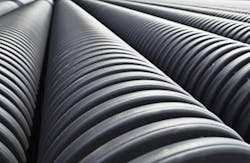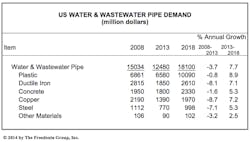Water and wastewater pipe demand in the U.S. will grow 7.7 percent per year to $18.1 billion in 2018, according to a report by The Freedonia Group. Gains will rebound from declines experienced during the 2008-2013 period, during which pipe markets were negatively impacted by decreases in construction spending. Strong increases in construction activity will fuel gains in the building construction market, while Freedonia predicts the continued need to upgrade and repair the country’s aging sewer and water pipe network will spur gains in the municipal market
In the municipal market, the majority of pipe demand is attributable to the repair and replacement of a large existing infrastructure. According to analyst Mike Deneen, “There is a pressing need for repairs and replacement; however, they are often deferred until a burst pipe requires immediate action. It is anticipated that water utilities will successfully increase end-user water and sewer fees over the forecast period, enabling them to more easily fund repair and replacement projects.
READ ALSO: As Congress Passes Water Infrastructure Bill, AWWA Study Reveals the Critical Need
In the building construction market, demand for water distribution and service pipe was severely constrained as new housing construction declined precipitously from 2006 through 2009, and nonresidential building activity contracted at double-digit rates in 2009 and 2010. Freedonia predicts a strong recovery will occur in the housing market, with the number of housing starts expected to post double-digit gains through 2018, spurring demand for water pipe, particularly distribution and service pipe.
Among pipe materials, metal will lose market share to plastic, continuing a long-term systemic trend. Demand for each type of metal pipe—ductile iron, copper, and steel—is forecast to be less in 2018 than it was in 2008, reflecting increased use of plastic pipe in both small- and large-diameter applications. High-density polyethylene (HDPE) pipe will continue to gain ground on copper and other competing pipe materials. This is particularly true for crosslinked polyethylene (PEX) pipe, which will continue to displace copper pipe in water distribution applications. Polyvinyl chloride (PVC) will remain the leading resin used in plastic pipe production due to its dominant position in large diameter applications. Despite the erosion of their market share to plastics, concrete and ductile iron pipe demand will retain significant market share due to widespread use in sewer, drainage, and water transmission applications.



